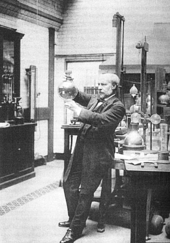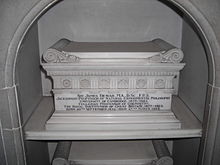James Dewar
Sir James Dewar | |
|---|---|
| Scientific career | |
| Fields | Physics, chemistry |
| Institutions | |
| Doctoral advisor | Lord Playfair |
Sir James Dewar
Early life
James Dewar was born in
Career
In 1875, Dewar was elected Jacksonian professor of natural experimental philosophy at the
alternative.In 1867 Dewar described several chemical formulas for benzene, which were published in 1869.[4] One of the formulae, which does not represent benzene correctly and was not advocated by Dewar, is sometimes still called Dewar benzene.[5] In 1869 he was elected a Fellow of the Royal Society of Edinburgh, his proposer being his former mentor, Lyon Playfair.[2]

His scientific work covers a wide field – his earlier papers cover topics including organic chemistry, hydrogen and its physical constants, high-temperature research, the temperature of the Sun and of the electric spark, spectrophotometry, and the chemistry of the electric arc.
With

His name is most widely known in connection with his work on the liquefaction of the so-called permanent gases and his researches at temperatures approaching absolute zero.[6] His interest in this branch of physics and chemistry dates back at least as far as 1874, when he discussed the "Latent Heat of Liquid Gases" before the British Association. In 1878, he devoted a Friday evening lecture at the Royal Institution to the then-recent work of Louis Paul Cailletet and Raoul Pictet, and exhibited for the first time in Great Britain the working of the Cailletet apparatus. Six years later, again at the Royal Institution, he described the researches of Zygmunt Florenty Wróblewski and Karol Olszewski, and illustrated for the first time in public the liquefaction of oxygen and air. Soon afterward, he built a machine from which the liquefied gas could be drawn off through a valve for use as a cooling agent, before using the liquid oxygen in research work related to meteorites; about the same time, he also obtained oxygen in the solid state.

By 1891, he had designed and built, at the Royal Institution, machinery which yielded liquid oxygen in industrial quantities, and towards the end of that year, he showed that both liquid oxygen and liquid ozone are strongly attracted by a magnet. About 1892, the idea occurred to him of using vacuum-jacketed vessels for the storage of liquid gases – the Dewar flask (otherwise known as a Thermos or
He next experimented with a high-pressure hydrogen jet by which low temperatures were realised through the Joule–Thomson effect, and the successful results he obtained led him to build at the Royal Institution a large regenerative cooling refrigerating machine. Using this machine in 1898, liquid hydrogen was collected for the first time, solid hydrogen following in 1899. He tried to liquefy the last remaining gas, helium, which condenses into a liquid at −268.9 °C, but owing to a number of factors, including a short supply of helium, Dewar was preceded by Heike Kamerlingh Onnes as the first person to produce liquid helium, in 1908. Onnes would later be awarded the Nobel Prize in Physics for his research into the properties of matter at low temperatures – Dewar was nominated several times, but never succeeded in winning the Nobel Prize.[7]
In 1905, he began to investigate the gas-absorbing powers of charcoal when cooled to low temperatures and applied his research to the creation of high vacuum, which was used for further experiments in atomic physics. Dewar continued his research work into the properties of elements at low temperatures, specifically low-temperature calorimetry, until the outbreak of World War I. The Royal Institution laboratories lost a number of staff to the war effort, both in fighting and scientific roles, and after the war, Dewar had little interest in restarting the serious research work that went on before the war. Shortages of scholars necessarily compounded the problems. His research during and after the war mainly involved investigating surface tension in soap bubbles, rather than further work into the properties of matter at low temperatures.
Family
He married Helen Rose Banks in 1871. They had no children. Helen was sister-in-law to both Charles Dickson, Lord Dickson and James Douglas Hamilton Dickson.[2]
Dewar's nephew, Dr Thomas William Dewar
Royal Institution Christmas Lectures
Dewar was invited to deliver several Royal Institution Christmas Lectures:
- A Soap Bubble (1878)
- Atoms (1880)
- Alchemy in Relation to Modern Science (1883)
- The Story of a Meteorite (1885)
- The Chemistry of Light and Photography (1886)
- Clouds and Cloudland (1888)
- Frost and Fire (1890)
- Air: Gaseous and Liquid (1893)
- Christmas Lecture Epilogues (1912)
Honours and awards
Whilst Dewar was never recognised by the
He was President of the Society of Chemical Industry from 1887-88.[13]
In 1904, he was the first British subject to receive the Lavoisier Medal of the French Academy of Sciences, and in 1906, he was the first to be awarded the Matteucci Medal of the Italian Society of Sciences. He was knighted in 1904 and awarded the Gunning Victoria Jubilee Prize for 1900–1904 by the Royal Society of Edinburgh, and in 1908, he was awarded the Albert Medal of The Society of Arts. A lunar crater was named in his honour.
A street within the
Later life

Dewar died on 27 March 1923 aged 80 and was cremated at Golders Green Crematorium in London. An urn with his ashes still resides there.
Character

Dewar's irascibility was legendary. Rowlinson (2012) called him "ruthless", particularly with his colleague Siegfried Ruhemann.[14]
Selected publications
- George Downing Liveing; James Dewar (1915). Collected Papers on Spectroscopy. University press.
Collected Papers on Spectroscopy.
, G. D. Living and J. Dewar, Cambridge University Press, 1915
- Pippard, Brian. 1993. "Siegfried Ruhemann (1859-1943), F.R.S. 1914-1923." Notes and Records of the Royal Society of London 47 (2): 271–76.
- Rowlinson, Sir J. S. 2012. Sir James Dewar, 1842–1923: A Ruthless Chemist. Ashgate Publishing, Ltd.
See also
- Cryogenic storage dewar
- Timeline of hydrogen technologies
- Timeline of low-temperature technology
References
- ^ "Dewar definition and meaning". Collins English Dictionary. 31 March 2024. Retrieved 31 March 2024.
- ^ ISBN 090219884X. Archived from the original(PDF) on 24 January 2013. Retrieved 18 September 2015.
- ^ "Dewar, James (DWR875J)". A Cambridge Alumni Database. University of Cambridge.
- ^ Dewar, James (1869) "On the oxidation of phenyl alcohol, and a mechanical arrangement adapted to illustrate structure in the non-saturated hydrocarbons," Proceedings of the Royal Society of Edinburgh 6: 82–86.
- ^ Baker and Rouvray, Journal of Chemical Education, 1978, vol. 55, p. 645.
- ^ "ABSOLUTE ZERO - PBS NOVA DOCUMENTARY (full length)". YouTube. Archived from the original on 6 April 2017. Retrieved 23 November 2016.
- ^ a b James, Frank. "Dewar, James". Chemistry Explained. Advameg Inc. Retrieved 22 May 2008.
- ^ "Sir James Dewar (1842 – 1923) | Kincardine Local History Group".
- ^ Sir James Dewar 1842-1923: A Ruthless Chemist, by Sir J S Rawlinson.
- ^ "Library and Archive Catalogue". Royal Society. Archived from the original on 27 February 2012. Retrieved 27 November 2010.
- ^ "APS Member History". search.amphilsoc.org. Retrieved 8 February 2024.
- ^ "James Dewar". nasonline.org. Retrieved 8 February 2024.
- ^ "SCI Presidents".
- ^ Pippard 1993; Salzman 2000
- This article incorporates text from a publication now in the public domain: Chisholm, Hugh, ed. (1911). "Dewar, Sir James". Encyclopædia Britannica. Vol. 8 (11th ed.). Cambridge University Press. p. 137.
Further reading
- Armstrong, H. E.; Perkin, A. G.; Armstrong, Henry E. (1928). "Obituary of James Dewar". Journal of the Chemical Society: 1056–1076. . Retrieved 30 August 2008.
- Bellis, Mary, "Inventors Sir James Dewar" from about.com
- Meiklejohn, William, "Tulliallan: Four lads o' pairts: Sir James Dewar (1842–1923)" from the Kincardine Local History Group
- Sella, Andrea (August 2008). "Dewar's Flask". Chemistry World: 75. Retrieved 30 August 2008.
- Sloane, Thomas O'Conor (1900). Liquid Air, and the Liquefaction of Gases. Henley., Liquid Air and the Liquefaction of Gases, Norman W. Henley and Co., New York, 1900, second edition (extensive description of Dewar's work on the liqufaction of gases)
External links
- Fullerian Professorships
- Brief biography from the Royal Institution of Great Britain
- Another brief biography
- "Archival material relating to James Dewar". UK National Archives.
- Correspondence with H.A. Kamerlingh Onnes, Dewar's competitor in the race to liquid helium.
